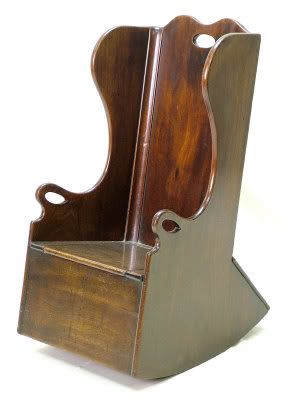 Thanks: 0
Thanks: 0
 Likes: 0
Likes: 0
 Needs Pictures: 0
Needs Pictures: 0
 Picture(s) thanks: 0
Picture(s) thanks: 0
Results 1 to 1 of 1
Thread: A simple plank rocking chair.
-
24th November 2008, 04:08 PM #1
 A simple plank rocking chair.
A simple plank rocking chair.
Early European furniture was the preserve of the very wealthy, but as methods of converting timber evolved and became more commonplace, skilled 'joyners' proliferated. In the early eighteenth century, carpenters would have made basic furniture for farmers too and anyone else who could afford it. The pieces of furniture were normally simplistic and utilitarian, but occasionally whimsical or luxury (relatively speaking) pieces were made.
The picture below shows such a piece, probably made for an old and presumably respected member of an early eighteenth century well-to-do country family.

The rocking chair still displays its utilitarian origins; the centre section of the seat lifts up revealing a large storage bin and the tail box also has a lift up lid. Once loaded with flour or other stores, the chair would be quite heavy to move around, so it would most likely have been a permanent fireside feature for the elderly sitter and the deep wings would have protected them from draughts.
What appeals to me is the simple plank construction and it struck me that with a lot of timber millers in Australia cutting wide slabs that someone here might wish to make a similar chair.
The sides, back and front are 1" thick and the remainder is 3/4" thick. The front of the seat is about 2.5" wider than the back. There are scotia mouldings in the back corners of the chair (presumably to strengthen it), but I suspect these were later additions. The original construction would have relied solely on treenails or smith-made iron nails..
I know you believe you understand what you think I wrote, but I'm not sure you realize that what you just read is not what I meant.
Regards, Woodwould.
-
24th November 2008 04:08 PM # ADSGoogle Adsense Advertisement
- Join Date
- Always
- Location
- Advertising world
- Posts
- Many
Similar Threads
-
Rocking chair.
By patrickdt10 in forum FURNITURE, JOINERY, CABINETMAKING - formerly BIG STUFFReplies: 11Last Post: 27th November 2008, 10:40 PM -
rocking chair
By weisyboy in forum WOODWORK - GENERALReplies: 20Last Post: 20th July 2007, 07:37 PM -
Rocking Chair help
By Lena_Saturn in forum WOODWORK - GENERALReplies: 6Last Post: 2nd December 2006, 06:30 PM -
My rocking chair
By Rocker in forum WOODWORK PICSReplies: 10Last Post: 30th September 2005, 03:36 AM






 Reply With Quote
Reply With Quote
